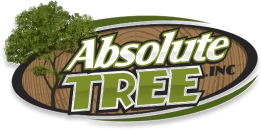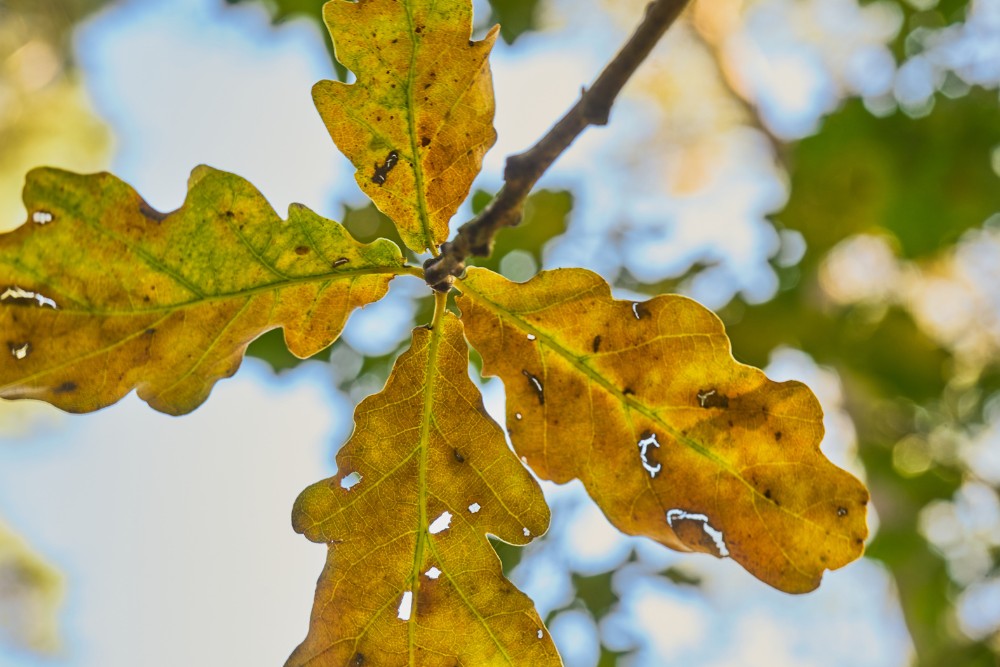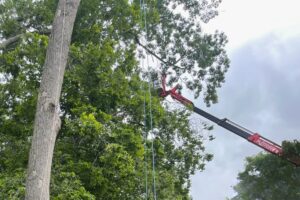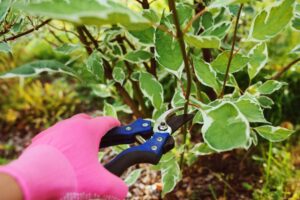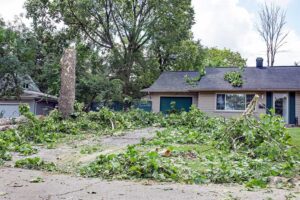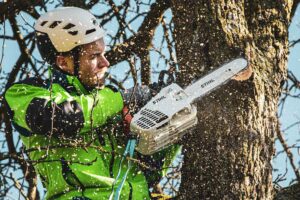Temperatures are rising, bugs are back, and that tree you’ve been watching come back to life all spring doesn’t look as good as you once remember. If you’re wondering whether it’s a seasonal hiccup or something more serious, it might be time for an arborist assessment.
Key Takeaways
- Dying trees, leaning trees, and damaged/discolored leaves are clear warning signs that you need a professional arborist assessment to determine if it is possible to save your trees.
- Recent storm damage in Northern Virginia can cause broken branches and structural issues that require professional evaluation to prevent future property damage.
- Exposed roots, girdling roots, and excessive woodpecker activity often indicate underlying tree health problems that need expert diagnosis and treatment.
- Overgrown, neglected trees need assessment from an arborist who can create a proper pruning plan, since removing too much at once can harm the tree.
- Professional arborist assessments can often identify solutions like pruning, disease treatment, or fertilization that save trees from unnecessary removal.
7 Signs You Need an Arborist Assessment in Northern Virginia
While trees may not have flashing signs that let you know something is wrong, there are some things to look for that may indicate a problem. If you aren’t sure what’s wrong with your trees and want a second opinion, consider an arborist assessment.
An arborist assessment will include a complete survey of your tree by a qualified ISA Certified Arborist. They will inspect the tree and note its condition and the danger it poses to your property. They can then provide you with an assessment and recommendations for the next steps.
Some of the common signs that indicate you need an arborist assessment include:
1. You Think Your Tree Might Be Dead
Dead trees are much more likely to fail, especially during storms or high winds, because they no longer have the strength of living wood. But decline often happens gradually, and many homeowners don’t notice until the tree stops leafing out or shows major signs of trouble.
If your tree isn’t growing leaves in spring or summer, it’s time to have an arborist take a look. They can confirm whether the tree is truly dead and needs to be removed to protect your property, or if it still has a chance and can be saved with proper care.
2. Your Tree is Leaning and Looking Dangerous
A leaning tree, especially one that developed the lean recently, is a cause for concern and worth having a professional investigate. A tree leaning a few degrees is likely not an issue. However, if it leans 15 degrees or more from vertical, it is now most likely a danger to your property.
Leaning trees are more prone to failure during a storm and might require removal. An arborist can examine the tree and give you an assessment of its ability to keep standing.
3. You Notice Damaged, Dead, or Discolored Leaves
Most trees should have beautiful, green leaves in the summer. When you look at them and they seem damaged, discolored, or otherwise unhealthy, it should be a wake-up call that something is wrong.
There are numerous reasons why your leaves may look off, such as:
- Insect and disease activity
- Lack of nutrients in the soil
- Summer heat and drought stress
Damaged or discolored leaves are no reason to jump to tree removal. Instead, an arborist inspecting your trees can explain why you have dead leaves or patches in the canopy.
4. There Was a Recent Storm in the Area
Storms can cause significant damage to your trees and break branches. Need an example? Look no further than a May 2025 storm that brought down trees and damaged canopies throughout Fairfax County.
Broken branches in trees may fall off or remain stuck in the canopy, ready to dislodge during the next storm and potentially cause property damage.
After a storm, an arborist assessment can give you an idea of the damage your tree suffered and what kind of care it needs. They may suggest pruning damaged or weakened branches or removing the tree altogether if the storm damage is too significant.
5. Your Tree Has Exposed or Damaged Roots
Ideally, a tree’s roots should be widespread and about two feet deep in the ground. However, this isn’t always the case, as issues like compacted soil or improper planting can lead to the roots exposing themselves or circling the tree trunk (known as girdling roots).
When you notice exposed roots or the signs of girdling roots, it is likely time to have an arborist inspect your trees. They can provide recommendations on correcting the problem or suggest removing a tree at risk of toppling.
6. There is Increased Woodpecker Activity Around Your Tree
The occasional pecking of a woodpecker isn’t much to worry about. However, when there is extensive woodpecker damage to your tree, it is likely a sign that something is wrong. Woodpeckers can detect insects under the bark and peck at your tree to try to eat them.
If you can’t get the sound of pecking out of your head and see several holes in the tree trunk, it might be time to have an arborist assess your trees. They can determine if they have an insect infestation and start a treatment program to try to save your trees.
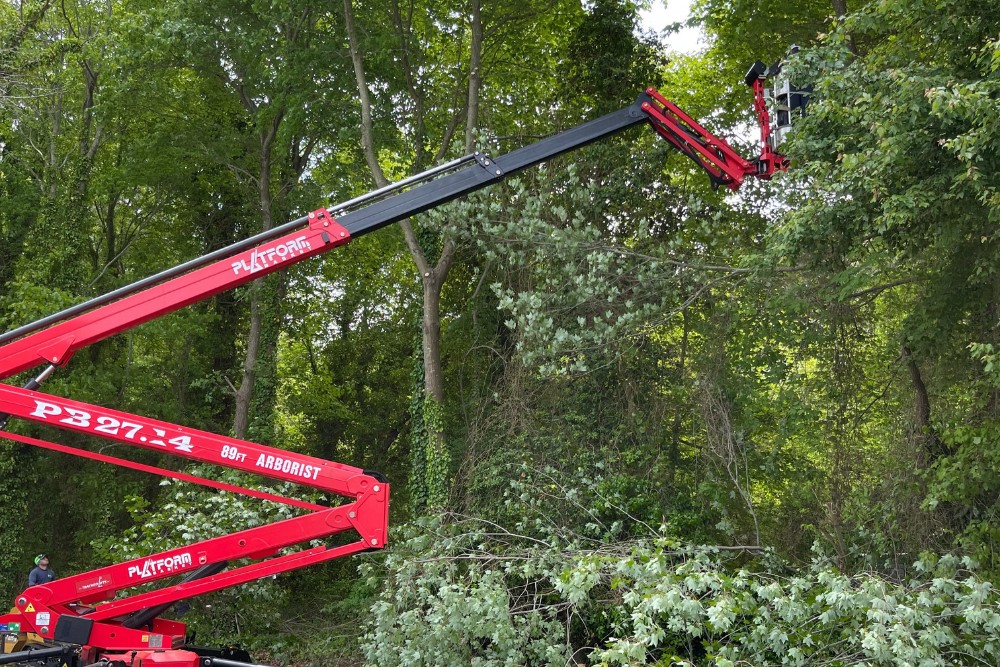
Pruning is often the best strategy for overgrown trees.
7. The Tree Appears to Be Overgrown
A neglected tree can end up becoming overgrown and in need of some attention. If you look at your tree and it has become far too large and has branches going everywhere, it may be time to have an arborist inspect it and determine the best way to prune it.
While it may seem tempting to trim an extensive amount of the tree to return it to a more compact size, pruning too much at one time will be detrimental to the tree. Instead, proper pruning involves keeping it light and targeted to select branches. An arborist can determine which branches to cut and create a long-term plan to restore your tree to its proper shape.
Frequently Asked Questions About Arborist Assessments
To help you better understand why you need an arborist assessment and the benefits of one, we’ve answered some of the common questions homeowners have about them.
What is an arborist assessment?
An arborist assessment is a detailed examination of your trees to determine and document any issues they may face. One of our arborists will investigate your trees and explain their problems and our suggested solutions to rectify them.
What are some alternatives to removing a tree that is struggling?
Don’t jump to tree removal just because your tree appears to be struggling. After an arborist assessment, we may recommend some of the following actions to address the tree’s problems:
- Pruning
- Insect or disease treatment
- Fertilization
- Soil aeration
How often should I have an arborist assessment on my property?
The frequency at which you get an arborist assessment will depend on the condition of your trees and if they have had problems in the past. A tree free of significant issues can probably go
around 5 years before it needs another inspection. However, a tree that looks to be in a stressed state or that has had numerous issues before may require more frequent inspections.
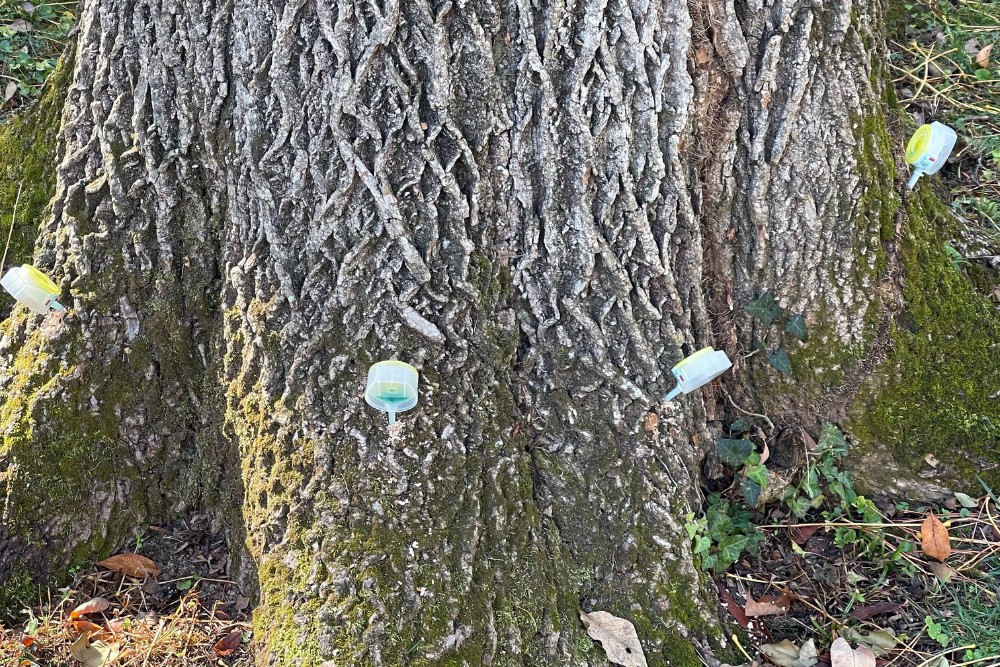
Trunk injections are one method tree services may use to help your tree prevent or recover from a disease.
Think Something’s Off With Your Tree? Let Absolute Tree Take a Look
If something in your yard has been causing concern – whether it’s a leaning trunk, dead branches, or signs you’ve seen in this list – don’t panic. It may just be time for a professional checkup to catch any underlying issues early. For a clear diagnosis and honest recommendations, trust the team at Absolute Tree.
We offer arborist assessments that can help determine the underlying causes of why your tree may have discolored leaves or damaged bark. Call us today at 703-969-6207 or request an estimate for an assessment of your trees and how to care for them.
For the Absolute Best Tree Service in Northern Virginia, call Absolute Tree Today!
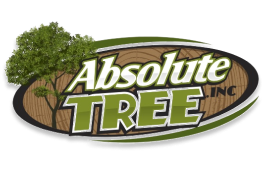
Author Profile: Ashley Davis
Over the last 19 years, Absolute Tree has grown a reputation as one of the premier tree service companies in the Northern Virginia areas. And there’s a good reason for this—we love trees and our passion for them shows. When you call on Absolute Tree for tree service, you aren’t just getting “some guys who cut down trees.” You’re hiring highly skilled arborists who understand the growth of trees and consider tree care an art form.
Stay Up-to-date!
Swing in each month for new articles, pest alerts, local resources, tree care tips, tree health updates, and landscape maintenance ideas
